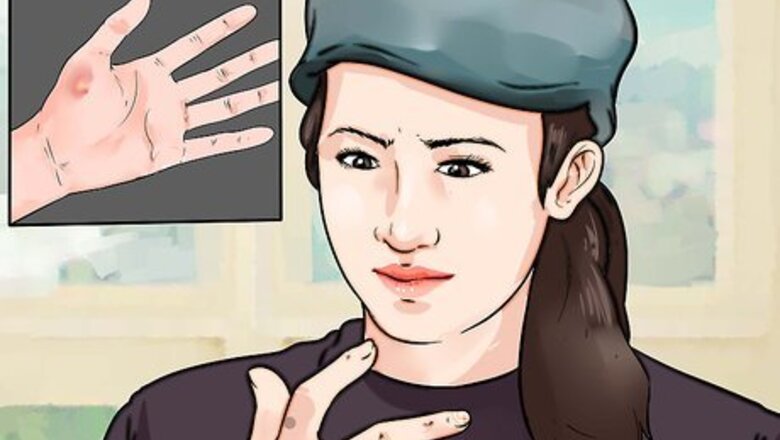
views
Taking Care of the Finger
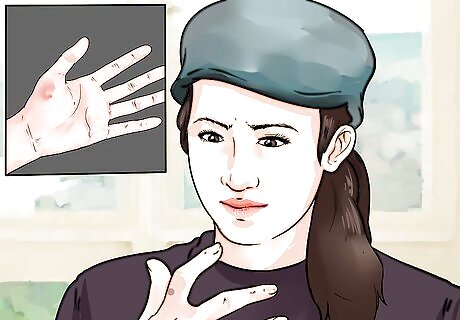
Check for swelling. Your finger will likely swell no matter how hard you hit it. This is the most common response to such trauma. If the hit wasn't too forceful, your finger may just swell for a couple of days. If the only symptom you see is swelling, place an ice pack on your finger to help relieve the swelling and pain. You can take over-the-counter pain medication to help relieve the pain as well. An NSAID (nonsteroidal anti-inflammatory drug) such as ibuprofen (Advil, Motrin IB) or naproxen sodium (Aleve) can help relieve the inflammation and pain. Take as directed on the packaging. You don't need to see a doctor unless the swelling won't go down, you develop serious pain or numbness, or you can't move your finger all the way in or all the way out.
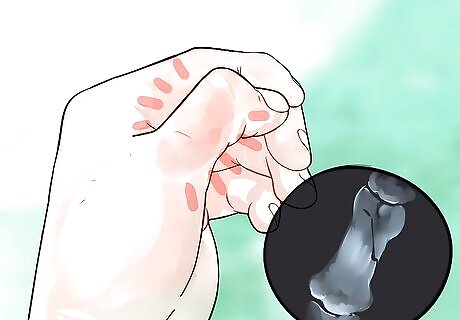
Respond to a fracture. If the swelling is really bad and you are in extreme pain, you may have fractured your finger, especially if you hit your finger quite hard. If your finger looks contorted and is extremely sensitive to the touch, you likely fractured your finger. This may be accompanied by bleeding skin or a smashed fingernail. If you think you have a fracture, seek medical attention. You need an X-ray and the doctor may give you a finger splint or some other form of treatment. Do not put a splint on your finger unless a doctor tell you to do so.
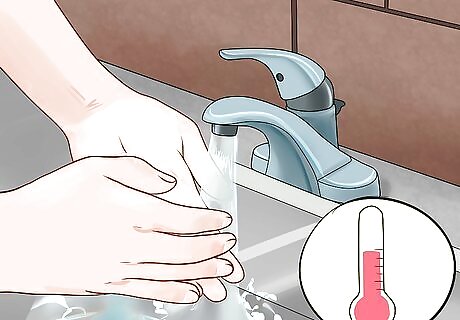
Clean the wound. If your finger is bleeding after you hit it, you need to clean the wound so you can assess the damage. If there is visible bleeding, cleanse the wound with running warm water. Run the warm water over the wound with the run-off going down the drain, not back into the wound. Then, using a gauze pad, cleanse the entire wound surface with Betadine or other cleansing solutions. Put pressure on your wound for a few minutes to slow the flow of blood, which will help you assess how deep the wound is and if you need to see a doctor. If there is excessive bleeding or squirting blood, seek medical attention immediately.
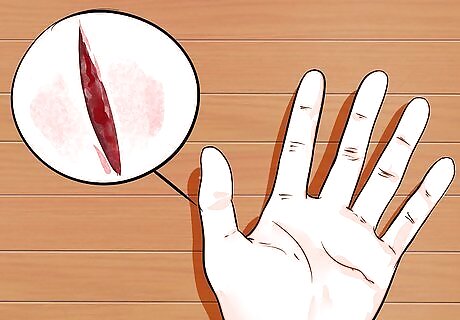
Assess the lacerations. Once you've cleaned the wound, you need to evaluate the finger for any lacerations, or cuts. The wound still may bleed a little while you check, which is fine. Lacerations often show up in the form of tears or flaps of skin on the surface of your finger. Any obviously destroyed tissue or any skin that has been torn off and left a raw bleeding finger pad needs to be examined by a doctor. Lacerations may need to be stitched if the wound is ⁄2 inch (1.3 cm) or larger. However, if there is a section of completely destroyed skin, it is unlikely to be salvaged. Many doctors will still suture damaged or destroyed skin over the raw finger pad as protection while new skin grows back over the area. The skin will them be removed once new skin has formed. Lacerations may be shallow and stop bleeding soon after you get them, especially if you didn't hit your finger that hard. If this is the case, wash the wound, put antibiotic ointment on them, and wrap them with a bandage.
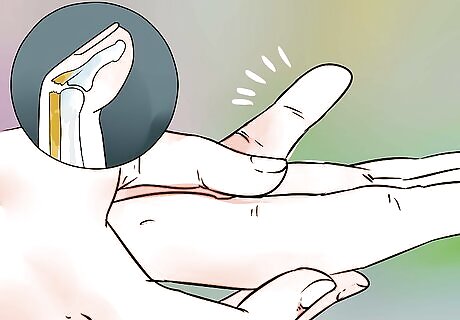
Look for tendon injury. Since your hand and fingers are an intricate system of muscles, tendons, and nerves, it's important to examine your finger for signs of tendon injury. Tendons connect muscles to your bones. Your hand has two types of tendons: flexor tendons, on the palm side, that bend the fingers; and extensor tendons, on the back of the hand, that straighten the fingers. Cuts and smashes can damage or even sever these tendons. A torn or cut tendon in the finger will make it impossible to bend your finger. A cut on the palm side of the hand or near the skin folds at the joints of your fingers may signal injury to the tendon below. You may also feel numbness due to associated nerve damage. Tenderness on the palm side of your hand may signal an injured tendon. You may want to request a hand surgeon if you show any of these signs, as repairing the hand and fingers can be a very intricate process.
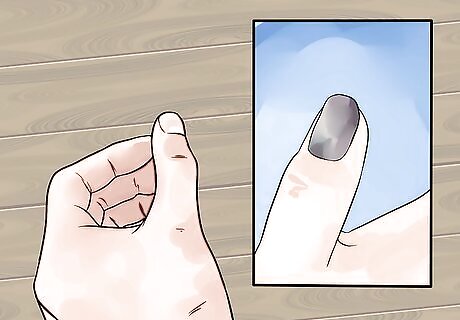
Evaluate the fingernail. If you hit your fingernail with the hammer, there may be significant damage to it. Look at your fingernail and assess the damage. If there is a small blood blister underneath the fingernail, there is no need to see a doctor. Just ice the wound and take over the counter medication if there is any initial pain. If the pain lasts for days, if the blood blister takes up more the 25% of your fingernail, or if the blood is causing significant pressure under your fingernail, seek medical attention. You likely have a subungual hematoma. You may also find that a portion of the fingernail has become detached or has been cut. If you have a significant cut in the nail bed, seek medical attention because you will likely need stitches. If you don't get it treated, the cut may prevent nail growth, cause the nail to grow in a distorted manner, or cause infection. If the fingernail is partially or entirely gone, seek medical attention right away. This is a serious problem and needs attention. The fingernail may be removed or stitched up until a new, healthy fingernail can grow back. This can take up to six months.
Treating a Subungual Hematoma

See your doctor. If the collection of blood under your fingernail is significant, which means it takes up more than 25% of your fingernail, see your doctor. You have a subungal hematoma, which is an area of broken small blood vessels under your fingernail. Your doctor will likely suggest that your nail get evacuated/lanced. When you react quickly enough you can do it yourself. If you notice severe throbbing, then push back the cuticle as far as it will go to gently slip in the sterilized needle. It will hurt less than your throbbing finger and the needle will go in easier at the nail base where it grows out. Let the blister drain a couple times until lymph flows (runs clear). This will prevent the black nail of dried blood under the nail. If the blood under the fingernail only covers 25% or less of your nail, you don't have to do anything to it. The blood will work itself up your fingernail as it grows. Depending on how hard your thumb was hit will mean how much your fingernail becomes black as the blood dries. If the hematoma is bigger than 50% of the fingernail, your doctor will request a finger X-ray. You should see a doctor to treat hematomas within 24-48 hours.
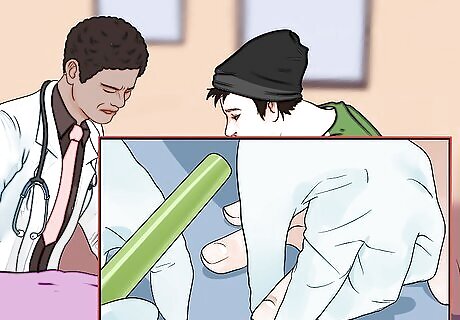
Evacuate the blood at the doctor's office. The safest way to evacuate the nail is to let your doctor perform the evacuation through cauterization. During this procedure, your doctor melts a small hole through your fingernail with an electric cauterization tool. Once the cautery hits the hematoma under the fingernail, the tip automatically cools. This prevents you from getting burned by the tool. After the hole is made, the blood oozes out of the fingernail until the pressure is relieved. Your doctor will then bandage your finger and send you home. The doctor may use an 18-gauge needle instead, although cauterization is preferred. This process is painless because your fingernail has no nerves in it. This process helps relieve pressure building up under the nail, which means you're less likely to need the nail removed.
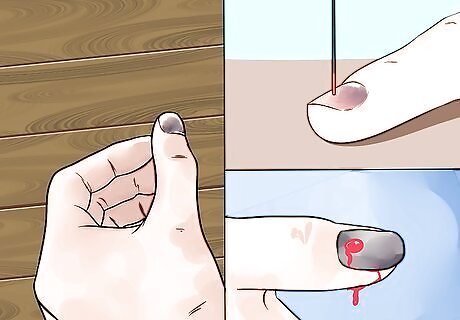
Get rid of the hematoma at home. Your doctor may advise you that it is okay to evacuate the hematoma at home. For this procedure, get a paperclip and a lighter and wash your hands thoroughly. Prepare the paper clip by unbending it and holding the lighter to the straight end until it is red and hot, about 10 to 15 seconds. Take the paper clip and place it at the center of the area that has the hematoma at a 90 degree angle from the nail bed. Gently press down with the paper clip, slowly twisting the hot paper clip edge back and forth in the same place to dig into the fingernail. Once you get through the fingernail, the blood will begin to ooze out of the nail. Grab a cloth or bandage to clean up the blood as it comes out. If you can't get through it at first, reheat the tip of the paper clip and retry, pressing down just a little bit harder to get through the fingernail. Do not do this too hard because you don't want to puncture your nail bed. You can take pain medication before you start if your finger is hurting you a lot. If you can't do it yourself, as a trusted friend or loved one to help you out.
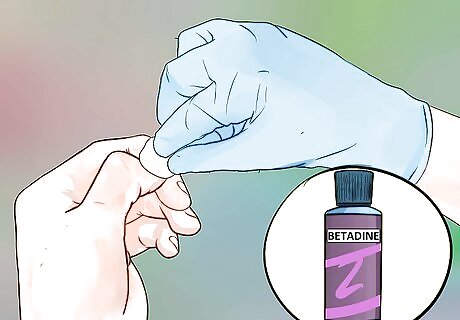
Re-clean the fingernail. Once all the blood has been drained, you need to clean the fingernail again. Clean the fingernail again with Betadine or some other cleansing solution. Bandage the finger in rolling gauze, making a ball out of the gauze at the top of your finger. This will provide better cushion and protection from outside irritants and trauma. Secure the gauze at the base with medical tape. You may want to anchor the gauze with a figure eight type maneuver that goes from your finger to the base of your hand. This will help the bandage stay on.
Continuing to Care for the Finger

Change the bandages. No matter what kind of damage or wound you have on your finger, change your dressings once a day. Change them sooner, however, if they become soiled before 24 hours have passed. When you take off the bandage each day, clean your finger with a sterile solution and rebandage it in the same manner you had it before. If you have stitches, ask your doctor before cleaning them. Follow any instructions he or she gives you on how to care for the stitches. You will likely have to keep them dry and should not clean them with any solution.
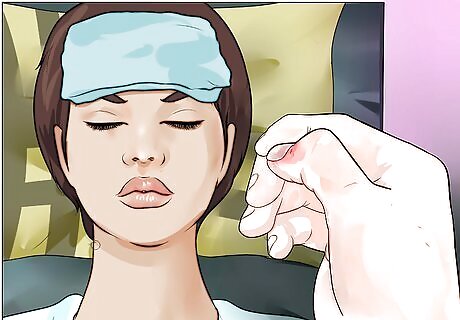
Look for signs of infection. Whenever you remove the bandages, look for signs of infection in the wound on your finger. Notice if there is any pus, drainage, redness, or heat, especially migrating up from your hand or arm. Also take note if you begin to run a fever, as complications can develop, including infections such as cellulitis, a felon, or other hand infections.

Follow up with your doctor. After you have had your finger injury for a few weeks, follow up with your doctor. If he or she treated the injury with stitches or hematoma evacuation, your doctor may schedule this. However, always follow up with your doctor when you go through any intense injury such as this. Make sure you contact the doctor if you have additional symptoms, think you may be getting an infection, you get dirt or grime into the wound and can't get it out, you experience any additional or excessive pain, or your wound starts to bleed uncontrollably. You should also contact your doctor if you experience any symptoms of nerve damage, including: a lack of sensation, numbness, or the development of a ball-like scar called a "neuroma" that is often painful and causes an electrical sensation when touched.












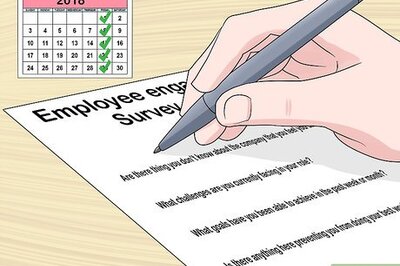




Comments
0 comment